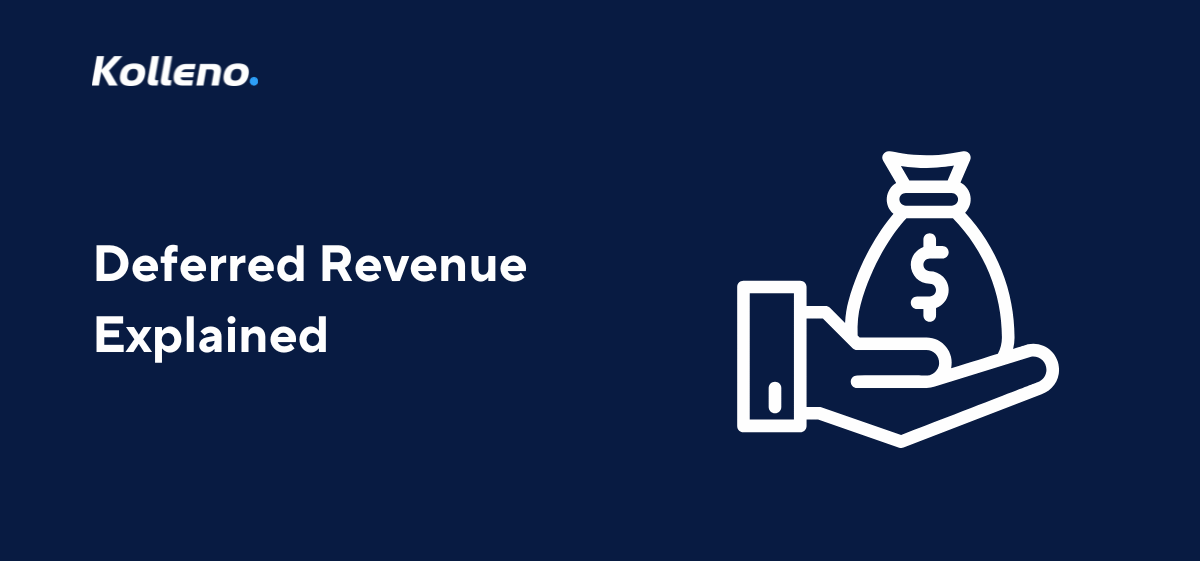Deferred revenue, also known as “unearned revenue”, is a key concept in accounting and financial management, particularly for businesses that receive payments before delivering goods or services. Understanding how to account for, report, and manage deferred revenue is critical for ensuring financial transparency and compliance with regulations.
In this guide, we will explore the concept of deferred revenue in-depth, including its recognition, how it impacts financial statements and best practices for managing it. Whether you’re a business owner, financial professional, or simply interested in understanding this essential accounting concept, this guide is for you.
1. What is Deferred Revenue?
Deferred revenue, also referred to as unearned revenue, occurs when a company receives payment from a customer for goods or services that have not yet been delivered. Unlike typical revenue, which is recognized upon the sale of a good or completion of a service, deferred revenue is recorded as a liability on the balance sheet. This is because the company has an outstanding obligation to the customer—until the agreed-upon goods are delivered or services are rendered, the revenue cannot be considered “earned.” Essentially, unearned revenue is money paid in advance for future goods or services, and recognizing it as revenue prematurely would misrepresent the company’s financial health.
Key Characteristics:
- Advance Payments: Deferred revenue typically arises from transactions where customers pay upfront. Common scenarios include subscriptions, software licenses, and prepaid services like rent or insurance.
- Unearned Status: The revenue is considered “unearned” because the company owes goods or services in the future. For example, a magazine company may receive an annual subscription payment but will recognize the revenue as each issue is delivered over the subscription period.
For subscription-based or service businesses, understanding deferred revenue is essential. It impacts both cash flow and financial reporting. While prepayments benefit liquidity, they require careful tracking to ensure proper revenue recognition.
2. Why is Deferred Revenue a Liability?
Deferred revenue appears as a liability on the balance sheet. Although the company receives payment, its obligation to deliver future goods or services justifies classifying it as a liability.
Why is it a Liability?
- Obligation to the Customer: The company has not yet “earned” the payment; it still owes something to the customer. This future obligation is why the payment is treated as a liability.
Risk of Refund: If the company fails to deliver the agreed-upon goods or services, it may need to refund the customer. Thus, deferred revenue remains a liability until the business fulfills its end of the transaction.
This treatment is in line with the Generally Accepted Accounting Principles (GAAP) and International Financial Reporting Standards (IFRS), which emphasize that revenue should only be recognized when it is earned, not when payment is received.
3. Recording Deferred Revenue in Accounting
The accounting treatment of deferred revenue involves creating a liability account to reflect the amount owed to the customer. When payment is received in advance, the company records this entry:
Journal Entry at the Time of Receiving Payment:
- Debit: Cash (to reflect the increase in cash or bank balance)
- Credit: Deferred Revenue (to reflect the increase in liabilities)
For example, a company offering a software-as-a-service (SaaS) subscription may receive a $12,000 payment for an annual plan. This amount is initially recorded as unearned revenue.
4. Recognizing Deferred Revenue Over Time
As the company provides the goods or services, the deferred revenue is recognized incrementally. Revenue recognition aligns with the fulfillment of the service or delivery of goods, and the journal entries are adjusted accordingly.
Monthly Recognition Example: Let’s assume the SaaS company delivers services equally over a 12-month period. At the end of each month, the company would recognize $1,000 in earned revenue.
Journal Entry for Each Month:
- Debit: Deferred Revenue $1,000 (to reduce the liability)
- Credit: Revenue $1,000 (to reflect the revenue earned)
This process continues until the entire $12,000 is recognized as revenue over the subscription term.
5. Deferred Revenue vs. Accrued Revenue
It’s important to distinguish between deferred revenue and accrued revenue, as they represent opposite concepts in accounting:
- Deferred Revenue: Payment is received before the goods or services are delivered.
- Accrued Revenue: Goods or services are delivered before payment is received.
While deferred revenue is classified as a liability, accrued revenue is an asset. Both are crucial for accurate financial reporting, ensuring that revenue is recognized in the correct periods.
6. Impact of Deferred Revenue on Financial Statements
Deferred revenue affects various financial statements, notably the balance sheet, income statement, and cash flow statement. Here’s how it influences each:
Balance Sheet:
- Deferred revenue appears under current liabilities (or long-term liabilities if the service extends beyond 12 months). It represents the company’s obligation to deliver future goods or services.
Income Statement:
- As the company earns the revenue, deferred revenue is transferred from the liability section to the revenue section on the income statement. This ensures that revenue is reported in the period it is earned.
Cash Flow Statement:
- The initial payment boosts cash flow, which can be beneficial for liquidity management. However, this cash inflow must be managed carefully to ensure that the company can meet its obligations over time.
Financial Implications:
- Transparency for Investors: Unearned revenue is often viewed positively by investors, as it reflects future revenue streams. However, businesses must be mindful not to overestimate revenue based on deferred payments.
Cash Flow Management: Although unearned revenue represents upfront cash, businesses must ensure they have sufficient resources to deliver the promised goods or services.
7. Real-World Examples of Deferred Revenue
Deferred revenue is common in various industries. Here are some typical examples:
- Subscription Services: Companies like Netflix, Amazon Prime, and SaaS providers often receive payments upfront for a year of service. The payments are recorded as deferred revenue and recognized monthly as the service is delivered.
- Airlines: When customers purchase tickets in advance, the payment is recorded as deferred revenue until the flight occurs.
- Insurance: Insurance companies often receive annual premiums upfront. These are recorded as deferred revenue and recognized monthly as coverage is provided.
- Gym Memberships: Many gyms offer annual memberships with upfront payments. The membership fees are recorded as unearned revenue and recognized over the course of the year.
Each of these examples illustrates how businesses manage and recognize deferred revenue to accurately reflect their financial health.
8. Industry-Specific Considerations
Deferred revenue plays a significant role in specific industries, especially those that rely on subscriptions, prepayments, or long-term contracts. Let’s look at a few industry-specific considerations:
- SaaS Companies: Deferred revenue is a major component for SaaS companies, where customers often pay for services that will be delivered over several months or even years. Managing unearned revenue is essential for SaaS businesses to demonstrate consistent revenue growth.
- Real Estate: In real estate, landlords may collect rent in advance. These payments are recorded as deferred revenue and recognized monthly as the rental period progresses.
Publishing: Publishers often receive payments upfront for magazine or newspaper subscriptions. Revenue is recognized over the subscription period as each issue is delivered.
9. How to Manage Deferred Revenue Effectively
Managing deferred revenue effectively is essential for companies that collect payments in advance for goods or services to be delivered in the future. Proper management ensures that revenue is recognized accurately over time, aligning with accounting standards and supporting financial transparency. To minimize the risk of misstatements and streamline financial reporting, businesses should adopt strategic practices in managing unearned revenue. Here are several best practices:
Implement Automation Tools
Using specialized accounting software to automate deferred revenue recognition simplifies the process and reduces the risk of human error. Automation tools allow companies to create schedules that recognize revenue incrementally based on contract terms or service delivery timelines. Many platforms also offer customizable options for different revenue streams, ensuring that each type of deferred revenue is tracked and recognized according to its specific terms. Automating this process improves efficiency and accuracy, freeing finance teams to focus on analysis and strategic planning.
Regular Reconciliation
Conducting regular reconciliation of deferred revenue accounts is vital to ensure that the recorded liability accurately reflects outstanding obligations. By periodically matching deferred revenue with the corresponding services or goods delivered, companies can identify discrepancies early and adjust their accounts accordingly. This practice helps avoid over- or under-recognition of revenue, which is crucial for maintaining accurate financial statements. Monthly or quarterly reconciliations are often ideal, allowing finance teams to track unearned revenue consistently.
Transparent Reporting
Deferred revenue can be complex, so it’s important to provide clear disclosures in financial statements about its nature, timing, and recognition policies. Transparent reporting builds trust with stakeholders, investors, and regulators, offering them insight into how and when the company expects to fulfill its obligations. In addition, comprehensive disclosures help demonstrate compliance with accounting standards like GAAP and IFRS, making it easier for auditors and investors to understand unearned revenue’s impact on the company’s overall financial health. Consider using notes to financial statements to detail the types of deferred revenue, recognition timelines, and any relevant risks associated with obligations.
Monitor Cash Flow
Deferred revenue brings an initial cash flow boost, but businesses must manage this influx carefully to ensure they can meet future service obligations. Developing a detailed cash flow forecast is essential to ensure that adequate funds are available for the costs associated with delivering products or services. Cash flow planning becomes especially important in industries like SaaS, publishing, or travel, where companies may collect large upfront payments but must spread service delivery over months or years. Monitoring cash flow also enables companies to strategize for growth opportunities or potential shortfalls while ensuring sufficient liquidity to meet deferred revenue commitments.
10. Legal and Regulatory Implications of Deferred Revenue
Unearned revenue is subject to strict accounting standards under GAAP and IFRS. Both standards require companies to recognize revenue only when it is earned. Failing to properly account for deferred revenue can lead to financial misstatements, audits, and potential legal consequences.
One of the key aspects of compliance with these standards is the clear differentiation between current and long-term liabilities. Unearned revenue must be categorized appropriately on the balance sheet to indicate the company’s obligations within the next fiscal year (current liabilities) versus those that extend beyond a year (long-term liabilities). This differentiation is essential for both internal financial planning and external reporting, as it provides stakeholders, investors, and regulators with a transparent view of the company’s pending obligations and overall financial stability.
Moreover, the recognition of unearned revenue has a direct impact on a company’s tax reporting. Since deferred revenue is recognized incrementally as the goods or services are delivered, companies need to manage their revenue recognition schedules carefully to avoid discrepancies that could lead to tax complications. Failure to align revenue recognition with the delivery of services or goods can distort income statements, potentially resulting in tax audits, additional tax liabilities, and adjustments to taxable income.
11. Conclusion
In summary, deferred revenue is a vital accounting concept for businesses across industries that operate with prepayments, subscriptions, or long-term contractual obligations. Properly managing and recognizing unearned revenue is crucial to maintain accurate financial statements, align with GAAP and IFRS standards. For businesses, this process not only helps in compliance but also provides insights into future revenue streams, giving stakeholders a clearer picture of financial health.
Effective deferred revenue management allows companies to leverage upfront payments to boost cash flow while accurately reflecting obligations on the balance sheet. Employing best practices such as using automated accounting software, performing regular reconciliations, and clearly reporting unearned revenue in financial disclosures improves transparency and reduces risks of misstatements. Businesses in fields like SaaS, publishing, real estate, insurance, and more can benefit significantly by correctly tracking unearned income, ensuring compliance, and effectively forecasting cash flow for sustainable growth.
Whether you’re a business owner, accountant, or financial analyst, a deep understanding of deferred revenue aids in making informed decisions, aligning with regulatory standards, and building long-term trust with clients, investors, and other stakeholders. Mastering deferred revenue management can be a strategic asset, helping businesses meet their financial obligations and position themselves for resilience and success in competitive markets.
- 1. What is Deferred Revenue?
- 2. Why is Deferred Revenue a Liability?
- 3. Recording Deferred Revenue in Accounting
- 4. Recognizing Deferred Revenue Over Time
- 5. Deferred Revenue vs. Accrued Revenue
- 6. Impact of Deferred Revenue on Financial Statements
- 7. Real-World Examples of Deferred Revenue
- 8. Industry-Specific Considerations
- 9. How to Manage Deferred Revenue Effectively
- 10. Legal and Regulatory Implications of Deferred Revenue
- 11. Conclusion




